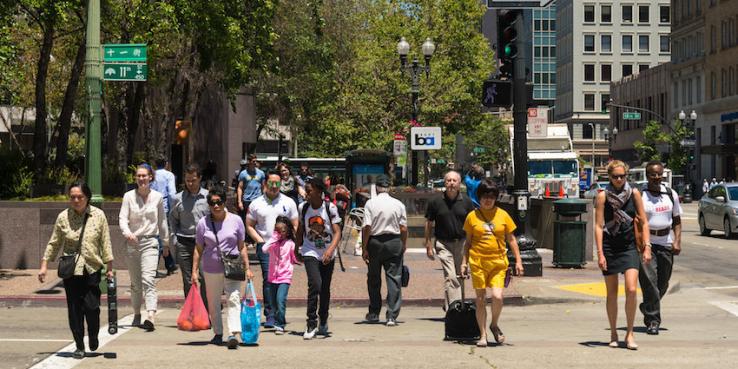The City of Oakland is currently writing its sixth neighborhood specific plan, and this time the neighborhood is downtown. When SPUR opened in Oakland last year, we also chose downtown as the focus for our first Oakland report, because the area is at a key moment in its history. Public and private investment have sparked a renaissance. Empty buildings are being renovated, companies are relocating or expanding downtown and commercial vacancies are way down. Cultural venues, restaurants, bars and retail stores are thriving. More people are moving in, and there are more jobs.
But as the attention and interest grow, downtown Oakland finds itself in a bind. The current revival hasn’t been strong enough to attract new construction, so too many of the institutions, residents and businesses responsible for making downtown Oakland great are now being displaced. This is harming Oakland’s character and making it more difficult for Oaklanders to remain a part of the city they love.
Lots of people are trying to figure out what to do about this. The Oakland City Council recently passed a 90-day moratorium blocking rent increases above 1 percent and evictions without just cause. An impact fee to pay for affordable housing is in the offing, and the mayor’s Housing Implementation Cabinet has recently released Oakland At Home: Recommendations for Implementing a Roadmap Toward Equity, which contains 10 strategies to safeguard housing affordability in Oakland and calls for protecting 17,000 units of affordable housing and creating another 17,000.
While all of these steps are important, the current downtown specific plan process offers a unique opportunity that must not be missed. The displacement trend will continue if downtown doesn’t build significant new housing and commercial spaces. The key is to think and plan big enough so that the downtown Oakland of the future has a chance to be the place that the city, its residents and the region all need it to be.
In our report A Downtown for Everyone: Shaping the Future of Downtown Oakland, we called on the city to make downtown a major regional employment center that brings tens of thousands more jobs downtown. A significantly larger number of jobs downtown is a critical component in an equity vision. Downtown Oakland is one of the region’s only truly transit-accessible job centers, and robust downtowns can provide a wide range of occupations across industries and skill levels. When combined with a strong workforce system that help lower-wage workers move into middle-wage jobs, adding lots more commercial space of all types — and lots more jobs — will help make Oakland a downtown for everyone. (For more see the Bay Area’s Economic Prosperity Strategy.)
The other major component, of course, is housing. In our report we called for at least 25,000 new residents. A key factor in revitalizing downtown has been the residential development of the last decade, but as anyone who has walked around downtown on evenings or weekends will tell you, the streets are still virtually empty and could use a lot more residents.
Oakland, like almost every other city in California, has been underbuilding the amount of housing it needs for decades. A recent report by the California Housing Partnership Corporation estimates that Oakland is 58,680 homes short of where it needs to be for very low-income and low-income families. The shortfall increases if moderate-income families are included. Downtown alone can’t solve this problem, but it is part of the answer and should provide new housing at all income levels.
A prime role of a vibrant downtown is to generate taxes and investment that allow everyone to benefit from economic growth. Downtown Oakland is the urban core of the city and a major regional transit hub. It holds the potential to be a much larger revenue-generating job center than it is now. New residents and workers can become new customers for retailers, restaurants, bars and entertainment venues, boosting revenue from sales tax. New residential and commercial developments pay higher property taxes, as well as one-time development fees. With additional revenue from these sources, the city would be able to better fund public safety improvements, provide more amenities like parks and recreation services, build more affordable housing and properly maintain infrastructure throughout the city.
SPUR hopes that the Downtown Specific Plan can help chart the way out of downtown’s current bind by stimulating growth that can create significantly more employment, provide more housing at all income levels, generate public benefits and provide enough room for small businesses, arts organizations and industrial users to thrive. Without planning for intense development downtown, it is likely that Oakland’s current phenomenon of displacement will only continue. It’s now up to the city, and especially the Downtown Specific Plan, to do everything possible to make sure that doesn’t happen.
